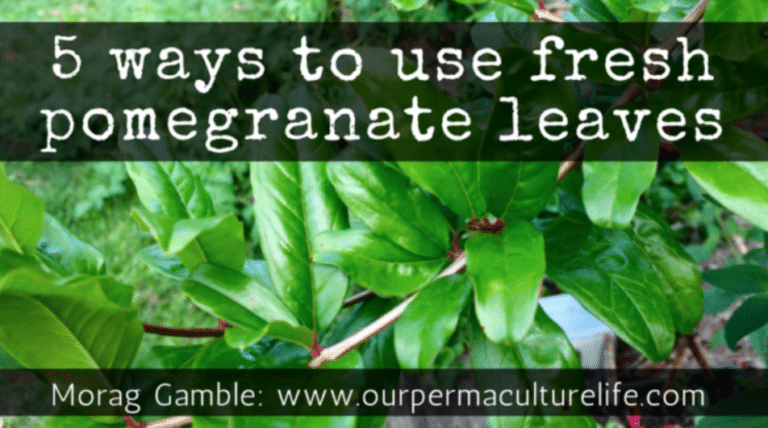
Did you know that you could use the leaves of your pomegranate tree, not just the fruit? There are many ways to use pomegranate leaves..
Use young leaves as
- a salad green.
- in a green smoothie or juice.
- As a spinach alternative – curries, pasta sauces, soups …
- To make leaf tea – fresh or dried.
- Make a paste from the leaf and put it on eczema directly.
Pomegranate leaf tea is good to drink just before bed for a good sleep, a great drink to soothe the stomach and ease digestion issues and also great to drink (with tulsi) for coughs. You can also boil down a pomegranate tea to 1/4 of the liquid and use it on cold sores and mouth ulcers.
In the video below, I talked about how to make the most out of pomegranate leaves:
While the leaves, the flowers, rinds, seeds and roots (see caution below) are all edible, typically pomegranate is grown for it’s fruit – the sweet-tart fruit that is full of large dark edible seeds. It is prized for it’s health-giving anti-oxidant properties.
It can however take 5-6 years before the tree fruits well. So don’t just wait. Respectfully harvest young soft leaves from the shrub. This actually helps to keep the shrub in good form. 
Consider perhaps growing a hedge of pomegranate. Your regular trimmings to keep it in shape become your food – and actually can easily be planted straight into the ground to make new plants. It makes a great living fence and also a potted plant.
Pomegranate is not fussy about soil. It’s actually quite a hardy plant but very ornamental. I have one growing just off my verandah. The leaves are glossy and attractive, the flowers are beautiful and the fruit too is quite amazing – in looks, taste and healthiness.

Pomegrante (Punica granatum) was originally from Persia and Greece. It grows well in the Mediterranean. It likes hot and dry summers and sets more fruit if it gets a cooler winter. I can successfully grow it here in the subtropics, although I doubt I get as much fruit as in other areas – which is why I am looking at it’s lovely leaves.

Plants are so amazing. I love learning about all the different ways we can use the diversity of trees in our edible gardens. They have so many benefits for us, and the garden system.
Caution: The root or bark of pomegranate are considered medicinal and because they contain alkaloids and need to be carefully consumed. The key is to not eat lots of this part – stick with the fruits and leaves. Here’s a detailed overview of the medicinal uses: https://www.ncbi.nlm.nih.gov/pmc/articles/PMC4007340/.
Happy gardening. Feel free to share this post.
Learn Permaculture with Morag Gamble
The Incredible Edible Garden – Online permaculture gardening course
Permaculture Educators Program – Online Permaculture Design Certificate and Permaculture Teacher Certificate

Subscribe to my YouTube channel:
To receive direct notification of all my films, you can subscribe my YouTube channel. Just click the red subscribe button on my YouTube channel: www.youtube.com/c/moraggambleourpermaculturelife

